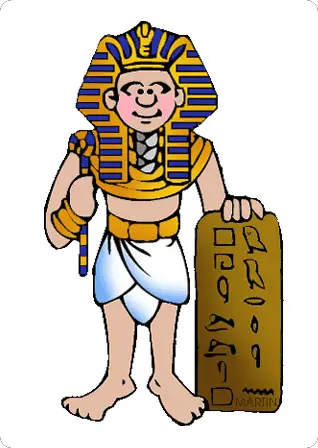Hatshepsut
In ancient Egypt, all pharaohs were supposed to be men. The title was passed down from father to son, or eldest male relative.
It wasn’t until a short while ago that archeologists found out that there actually was a female pharaoh.
The reason they didn’t know about her is that after she passed away, the people that were left tried to hide that she ever existed.
Hatshepsut was one of the most successful pharaohs that reigned in Egypt.

Hatshepsut Facts for Kids
- Hatshepsut was a female pharaoh of Egypt.
- She ruled Egypt for over 20 years.
- Hatshepsut focused on trade instead of war.
- She built many grand monuments, including temples.
- Hatshepsut had a unique burial tomb design.
- Her legacy was erased by her nephew, Thutmose III.
Hatshepsut was actually the queen of a pharaoh, King Thutmose II. After he died she took the title of ‘regent’ to her nephew (Thutmose III) who was a baby and next in line.
A regent is a kind of guardian for a pharaoh when they are too young to make decisions. It falls on the regent to make all of the decisions in the place of the young pharaoh.
Hatshepsut played the role of ‘regent’ until suddenly, she decided that she was a pharaoh.
No one is sure why, but she began to dress in the same male pharaoh clothes and even wore the pharaoh’s “beard’ which was part of their sign of power.
It is believed she dressed that way because they didn’t have any way for a female pharaoh to dress.
Hatshepsut: The Peaceful Pharaoh Who Led Egypt to Prosperity”
During the time that Hatshepsut ruled, Egypt did very well. Unlike the other pharaohs, she was more interested in expanding the economy and negotiating peaceful deals. She wasn’t interested in war.
She knew that the Egyptian people would profit better this way. Hatshepsut built new monuments but also restored some of the older buildings.
During her ninth year of reigning she sent trading expeditions to the land of Punt. The ships came back with ivory, gold, myrrh, and trees.
Hatshepsut’s Temple and Unique Burial Tomb

One of her finest buildings was the temple Djeser-djeseru (which means the holiest of holy places).
This was dedicated to the god Amon. She continued to build and add monuments throughout Egypt.
One of the two red granite obelisks still stands at the temple of Amon in Karnak.
It was a tradition that each pharaoh built their burial tomb while they were alive. Most of the pharaohs built pyramid-style tombs.
Hatshepsut decided to build a totally different type and designed it so that it looked like it was built into the mountainside.
Hatshepsut’s Tragic End and Erasure from History
Archeologists and scientists believe that Hatshepsut had a skin disorder and used a particular salve to try to heal it.
The salve contained a poisonous substance, and, using it for so long, it is believed that this is what killed her.
Once she had passed away, Thutmose III, her nephew went throughout the kingdom and destroyed all of the images of Hatshepsut that he could find.
He wanted to erase all of the work she had done, including any inscriptions.
He even had a wall built around her obelisks. Some thought he might have done this in revenge, but it is probably so that he could remind the people that he was pharaoh now.
The Rediscovery of Hatshepsut’s Tomb and Her Legacy
In 1902, when her tomb was discovered, they didn’t find any mummies. It wasn’t until years later that they found two female mummies, but one didn’t have an identification.
In 2007, they used the DNA from the tooth of the unidentified mummy to confirm that it was Hatshepsut.
Because almost everything that had her name engraved on it was destroyed, very little was ever said about this pharaoh.
Now, Egyptologists know that she was one of the best pharaohs that ever lived in Egypt and brought success and prosperity to the land.
Egyptologists and archeologists have spent years excavating and repairing the tomb of Hatshepsut.
It remains today as one of the most beautiful and unusual tombs of any of the Egyptian pharaohs.



